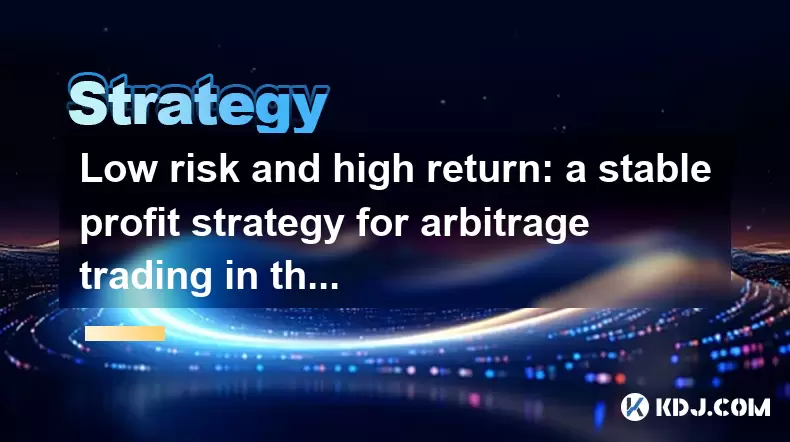-
 bitcoin
bitcoin $112195.049338 USD
2.42% -
 ethereum
ethereum $4124.915858 USD
2.81% -
 tether
tether $1.000570 USD
0.02% -
 xrp
xrp $2.861568 USD
2.25% -
 bnb
bnb $1000.346670 USD
3.04% -
 solana
solana $209.070819 USD
3.38% -
 usd-coin
usd-coin $0.999870 USD
0.02% -
 dogecoin
dogecoin $0.235379 USD
2.65% -
 tron
tron $0.335681 USD
-0.20% -
 cardano
cardano $0.803501 USD
3.38% -
 hyperliquid
hyperliquid $47.120881 USD
3.56% -
 chainlink
chainlink $21.501300 USD
3.44% -
 ethena-usde
ethena-usde $1.000571 USD
0.02% -
 avalanche
avalanche $29.793378 USD
3.62% -
 stellar
stellar $0.366964 USD
2.42%
Low risk and high return: a stable profit strategy for arbitrage trading in the cryptocurrency circle
Arbitrage trading in crypto exploits price differences across exchanges for profit, requiring speed, efficiency, and careful risk management.
Jun 06, 2025 at 11:07 am

In the dynamic world of cryptocurrency, arbitrage trading has emerged as a strategy that promises both low risk and the potential for high returns. Arbitrage involves taking advantage of price discrepancies of the same asset across different markets or exchanges. This article delves into how you can implement a stable profit strategy for arbitrage trading within the cryptocurrency circle, ensuring you understand every nuance of this approach.
Understanding Cryptocurrency Arbitrage
Cryptocurrency arbitrage is a trading strategy that exploits price differences of a cryptocurrency on various exchanges. For instance, if Bitcoin is trading at $30,000 on Exchange A and $30,200 on Exchange B, a trader can buy Bitcoin on Exchange A and simultaneously sell it on Exchange B, pocketing the $200 difference as profit. The key to successful arbitrage lies in speed and efficiency, as price differences can disappear in moments.
Types of Arbitrage in Cryptocurrency
There are several types of arbitrage strategies within the cryptocurrency market:
- Simple Arbitrage: This involves buying a cryptocurrency on one exchange where the price is lower and selling it on another where the price is higher.
- Triangular Arbitrage: This strategy involves trading three different cryptocurrencies to exploit discrepancies in their relative prices. For example, converting Bitcoin to Ethereum, then Ethereum to Litecoin, and finally Litecoin back to Bitcoin, ideally ending with more Bitcoin than you started with.
- Cross-Border Arbitrage: This type involves exploiting price differences in the same cryptocurrency on exchanges located in different countries.
Each type offers unique opportunities and challenges, but the core principle remains the same: capitalize on price inefficiencies.
Setting Up for Arbitrage Trading
To start arbitrage trading, you need to set up accounts on multiple cryptocurrency exchanges. Here’s how you can do it:
- Choose Exchanges: Select exchanges that are reliable and have significant trading volumes. Popular choices include Binance, Coinbase, and Kraken.
- Register and Verify: Create accounts on the chosen exchanges and complete the necessary KYC (Know Your Customer) verification processes.
- Deposit Funds: Fund your accounts with the required amount of fiat or cryptocurrency to start trading.
- Use API Keys: Many traders use API keys to automate trading. Ensure you set up secure API keys for each exchange to facilitate quick and efficient trades.
Executing an Arbitrage Trade
Executing an arbitrage trade involves several steps, each crucial to the success of the strategy:
- Monitor Prices: Use a price tracking tool or software to monitor prices across different exchanges in real-time.
- Identify Opportunities: Look for significant price differences that justify the transaction costs.
- Execute Trades: Once an opportunity is identified, execute the buy order on the exchange with the lower price and the sell order on the exchange with the higher price.
- Transfer and Withdraw: After the trades are completed, transfer any remaining funds or cryptocurrencies to a secure wallet.
Managing Risks in Arbitrage Trading
While arbitrage is considered low risk, it is not without its challenges. Here are some risk management strategies:
- Transaction Costs: Always factor in transaction fees, withdrawal fees, and deposit fees, as they can significantly impact your net profit.
- Price Slippage: Be aware of price slippage, where the price moves against you between the time you place your order and when it is executed.
- Liquidity Risks: Ensure there is enough liquidity on both exchanges to complete your trades without significantly impacting the price.
- Regulatory Risks: Be aware of the regulatory environment of the countries where the exchanges operate, as changes in regulations can affect your ability to trade.
Tools and Software for Arbitrage
To enhance your arbitrage trading, consider using specialized tools and software. Some popular options include:
- Arbitrage Bots: These are automated systems that can execute trades much faster than a human could. Examples include Blackbird and HaasOnline.
- Price Tracking Platforms: Platforms like Coinigy and CryptoCompare offer real-time price tracking across multiple exchanges.
- Spreadsheets and Custom Scripts: For those who prefer a more hands-on approach, custom scripts and spreadsheets can be used to monitor and calculate arbitrage opportunities.
Case Study: A Real-World Arbitrage Example
To illustrate how arbitrage works in practice, let's consider a hypothetical example:
Suppose Bitcoin is trading at $30,000 on Exchange A and $30,300 on Exchange B. You have $30,000 available to trade.
- Step 1: Buy 1 Bitcoin on Exchange A for $30,000.
- Step 2: Transfer the Bitcoin to Exchange B.
- Step 3: Sell the Bitcoin on Exchange B for $30,300.
After accounting for transaction fees, you could potentially net a profit of approximately $200. This example demonstrates the simplicity and potential profitability of arbitrage trading.
Frequently Asked Questions
Q: How much capital is needed to start arbitrage trading in cryptocurrencies?A: The amount of capital needed can vary widely depending on the scale of your trading. For beginners, starting with a few hundred to a few thousand dollars can be sufficient to learn and practice the strategy. However, larger capital can increase the potential for profit due to the ability to take advantage of more significant price discrepancies.
Q: Can arbitrage trading be fully automated?A: Yes, arbitrage trading can be fully automated using arbitrage bots. These bots can monitor multiple exchanges and execute trades automatically when certain conditions are met. However, setting up and maintaining these bots requires technical knowledge and constant monitoring to ensure they operate correctly.
Q: Is arbitrage trading legal?A: Arbitrage trading is generally legal, but it is essential to be aware of the specific regulations in the countries where the exchanges are based. Always ensure compliance with local laws and regulations when engaging in arbitrage trading.
Q: How do I handle the risk of exchange failures or hacks?A: To mitigate the risk of exchange failures or hacks, it is crucial to diversify your funds across multiple exchanges and not keep large amounts of cryptocurrency on any single exchange for extended periods. Additionally, using cold storage wallets for the majority of your holdings can provide an extra layer of security.
Disclaimer:info@kdj.com
The information provided is not trading advice. kdj.com does not assume any responsibility for any investments made based on the information provided in this article. Cryptocurrencies are highly volatile and it is highly recommended that you invest with caution after thorough research!
If you believe that the content used on this website infringes your copyright, please contact us immediately (info@kdj.com) and we will delete it promptly.
- News, September 28th, Headlines: Crypto's Wild Ride
- 2025-09-29 20:45:13
- Altcoins, Investors, and Potential Gains: Riding the 2025 Crypto Wave
- 2025-09-29 20:45:13
- Citi Token Services: Revolutionizing Cross-Border Payments and Liquidity Management
- 2025-09-29 20:50:01
- JYAI Token Gears Up for Launch: LCX Exchange Listing Imminent
- 2025-09-29 20:50:01
- Prenetics, Bitcoin Holdings, and Corporate Bitcoin: A New Era?
- 2025-09-29 20:25:11
- Swift, Altcoins, and Shifting Sands: Diving into Crypto's Latest Details
- 2025-09-29 20:25:11
Related knowledge

Practical parameter settings for a Bitcoin multi-timeframe moving average system
Sep 18,2025 at 10:54pm
Optimizing Timeframe Combinations for Bitcoin Trading1. Selecting appropriate timeframes is crucial when building a multi-timeframe moving average sys...

How can I filter out false breakouts in Dogecoin high-frequency trading?
Sep 22,2025 at 01:00am
Understanding False Breakouts in Dogecoin Trading1. A false breakout occurs when Dogecoin's price appears to move beyond a defined support or resistan...

Techniques for identifying tops and bottoms in the Bitcoin on-chain NVT model
Sep 20,2025 at 07:54pm
Understanding the NVT Model in Bitcoin Analysis1. The Network Value to Transactions (NVT) ratio is often described as the 'P/E ratio' of the cryptocur...

What does the surge in open interest in Bitcoincoin futures mean?
Sep 20,2025 at 11:18pm
Understanding the Surge in Dogecoin Futures Open Interest1. A surge in open interest within Dogecoin futures indicates a growing number of active cont...

How can I use the Ethereum USDT premium to gauge market sentiment?
Sep 18,2025 at 11:55pm
Understanding the Ethereum USDT Premium1. The Ethereum USDT premium refers to the price difference between USDT (Tether) traded on Ethereum-based plat...

What should I do if Ethereum staking yields decline?
Sep 20,2025 at 06:18am
Understanding the Causes Behind Declining Ethereum Staking Yields1. The Ethereum network transitioned to a proof-of-stake consensus mechanism with the...

Practical parameter settings for a Bitcoin multi-timeframe moving average system
Sep 18,2025 at 10:54pm
Optimizing Timeframe Combinations for Bitcoin Trading1. Selecting appropriate timeframes is crucial when building a multi-timeframe moving average sys...

How can I filter out false breakouts in Dogecoin high-frequency trading?
Sep 22,2025 at 01:00am
Understanding False Breakouts in Dogecoin Trading1. A false breakout occurs when Dogecoin's price appears to move beyond a defined support or resistan...

Techniques for identifying tops and bottoms in the Bitcoin on-chain NVT model
Sep 20,2025 at 07:54pm
Understanding the NVT Model in Bitcoin Analysis1. The Network Value to Transactions (NVT) ratio is often described as the 'P/E ratio' of the cryptocur...

What does the surge in open interest in Bitcoincoin futures mean?
Sep 20,2025 at 11:18pm
Understanding the Surge in Dogecoin Futures Open Interest1. A surge in open interest within Dogecoin futures indicates a growing number of active cont...

How can I use the Ethereum USDT premium to gauge market sentiment?
Sep 18,2025 at 11:55pm
Understanding the Ethereum USDT Premium1. The Ethereum USDT premium refers to the price difference between USDT (Tether) traded on Ethereum-based plat...

What should I do if Ethereum staking yields decline?
Sep 20,2025 at 06:18am
Understanding the Causes Behind Declining Ethereum Staking Yields1. The Ethereum network transitioned to a proof-of-stake consensus mechanism with the...
See all articles


























![[Pycoin] PI Coin -Shocking Listance of Pycoin?! 'Rebellion' This time ... Pay attention to #paikoin [Pycoin] PI Coin -Shocking Listance of Pycoin?! 'Rebellion' This time ... Pay attention to #paikoin](/uploads/2025/09/29/cryptocurrencies-news/videos/pycoin-pi-coin-shocking-listance-pycoin-rebellion-time-pay-attention-paikoin/68da82f23cec1_image_500_375.webp)















































